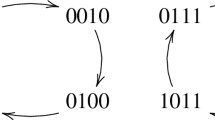Abstract
Let \(\chi \) denote the class of all groups G such that \(\Phi (G)\cap Z(G)=1.\) In this paper, it is shown that the converse of Baer’s theorem holds for the groups in \(\chi .\) Then we prove that the existence of the isomorphism between the center factors of the groups in \(\chi \) suffices for those groups to be isoclinic. We also prove that the isoclinism coincides with the n-isoclinism in \(\chi \). Finally, we obtain a criterion for c-capability of finite groups in \(\chi \).
Similar content being viewed by others
References
Baer R, Groups with preassigned central and central quotient group, Trans. Am. Math. Soc. 44 (1938) 387–412
Baer R, Representations of groups as quotient groups, I, II and III, Trans. Am. Math. Soc. 58 (1945) 295–419
Baer R, Endlichkeitskriterien für kommutatorgruppen, Math. Ann. 124 (1952) 161–177
Beyl F, Felgner U and Schmid P, On groups occurring as center factor groups, J. Algebra 61 (1979) 161–177
Burns J and Ellis G, On the nilpotent multipliers of a group, Math. Z. 226 (1997) 405–428
Ellis G, On groups with a finite nilpotent upper central quotient, Arch. Math. 70 (1998) 89–96
Hall P, The classification of prime power groups, J. Reine Angew. Math. 182 (1940) 130–141
Hall P, Finite-by-nilpotent groups, Proc. Camb. Philos. Soc. 52 (1956) 611–616
Hall M and Senior J K, The groups of order \(2^n\ (n\le 6)\) (1964) (Macmillan: New York)
Hatamian R, Hassanzadeh M and Kayvanfar S, A converse of Baer’s theorem, Ric. Mat. (2013). https://doi.org/10.1007/s11587-013-0172-6
Hekster N S, On the structure of \(n\)-isoclinism classes of groups, J. Pure Appl. Algebra 40 (1986) 63–85
Karpilovsky G, The schur multiplier (1987) (Oxford: Clarendon Press)
Leedham-Green C R and McKay S, Baer invariants, isologism, varietal laws and homology, Acta Math. 137 (1976) 99–150
Moghaddam M R R and Kayvanfar S, A new notion derived from varieties of groups, Algebra Colloq. 4 (1997) 1–11
Podoski K and Szegedy B, Bound for the index of the center in capable groups, Proc. Am. Math. Soc. 133 (2005) 3441–3445
Robinson D J S, A course in the theory of groups (1982) (New York: Springer)
Schur I, Über die darstellung der endlichen gruppen durch gebrochene lineare substitutionen, J. Reine Angew. Math. 127 (1904) 20–50
Author information
Authors and Affiliations
Corresponding author
Additional information
Communicating Editor: B Sury
Rights and permissions
About this article
Cite this article
Chakaneh, M., Kaheni, A. & Kayvanfar, S. On \({{\varvec{c}}}\)-capability and \({{\varvec{n}}}\)-isoclinic families of a specific class of groups. Proc Math Sci 129, 50 (2019). https://doi.org/10.1007/s12044-019-0484-x
Received:
Accepted:
Published:
DOI: https://doi.org/10.1007/s12044-019-0484-x



